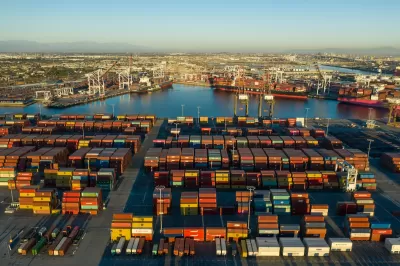The project, which will break ground this summer, is expected to dramatically curb emissions from trucking.

The rail yard at the Port of Long Beach, one of the nation’s busiest, is about to double in size after the port breaks ground on a massive expansion project later this year, reports Isabel Sami in L.A. Business First.
The project centers on a $1.6-billion on-dock rail support facility that will expand the yard from 11 to 48 rail tracks and “enhance on-dock rail capacity at the port’s shipping terminals by expanding the existing Pier B rail yard and connecting it to on-dock rail facilities and the Alameda Corridor railway.”
The entire project is slated for completion by 2032, with some components becoming operational sooner. According to Port of Long Beach CEO Mario Cordero, “completion of the project will reduce nitrogen oxide emissions by 26%, sulfur oxide emissions by 80% and particulate matter by about 85%” by streamlining rail operations and reducing truck trips. “Cordero said the project will get more trucks off the road, cutting emissions from the diesel-powered trucks that the port is looking to eliminate.”
The project is partly funded by $158 million from the California State Transportation Agency and $79 million in grant funding from the Los Angeles County Metropolitan Transportation Authority (Metro), the California Department of Transportation (Caltrans) and the U.S. Department of Transportation.
FULL STORY: Port of Long Beach rail expansion project to break ground this summer

Alabama: Trump Terminates Settlements for Black Communities Harmed By Raw Sewage
Trump deemed the landmark civil rights agreement “illegal DEI and environmental justice policy.”

Planetizen Federal Action Tracker
A weekly monitor of how Trump’s orders and actions are impacting planners and planning in America.

The 120 Year Old Tiny Home Villages That Sheltered San Francisco’s Earthquake Refugees
More than a century ago, San Francisco mobilized to house thousands of residents displaced by the 1906 earthquake. Could their strategy offer a model for the present?

In Both Crashes and Crime, Public Transportation is Far Safer than Driving
Contrary to popular assumptions, public transportation has far lower crash and crime rates than automobile travel. For safer communities, improve and encourage transit travel.

Report: Zoning Reforms Should Complement Nashville’s Ambitious Transit Plan
Without reform, restrictive zoning codes will limit the impact of the city’s planned transit expansion and could exclude some of the residents who depend on transit the most.

Judge Orders Release of Frozen IRA, IIJA Funding
The decision is a victory for environmental groups who charged that freezing funds for critical infrastructure and disaster response programs caused “real and irreparable harm” to communities.
Urban Design for Planners 1: Software Tools
This six-course series explores essential urban design concepts using open source software and equips planners with the tools they need to participate fully in the urban design process.
Planning for Universal Design
Learn the tools for implementing Universal Design in planning regulations.
Clanton & Associates, Inc.
Jessamine County Fiscal Court
Institute for Housing and Urban Development Studies (IHS)
City of Grandview
Harvard GSD Executive Education
Toledo-Lucas County Plan Commissions
Salt Lake City
NYU Wagner Graduate School of Public Service





























